In Kyoto wohnen wir im Shirakawa Guesthouse, bestens gelegen zwischen Tempeln, Einkaufsstraßen, Altstadt und U-Bahn in einem idyllischen Gassengewirr. Nicht ganz günstig, wir zahlen ein Drittel mehr als in Tokio, aber Kyoto ist insgesamt hochpreisiger.
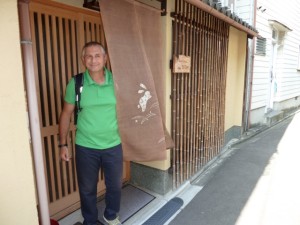

Unser Zimmer ist für japanische Verhältnisse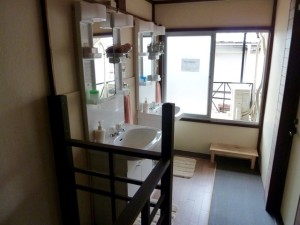 groß und für deutsche Verhältnisse minimalistisch: zwei Futons ein niedriges Tischchen, das war’s. Die sanitären Anlagen werden geteilt: drei Toiletten, die Dusche und eine kleine Küche im Erdgeschoss, zwei Waschbecken hier oben bei uns auf dem Flur im ersten Stock. War erst mal eine komische Vorstellung, aber alles ist so blitzesauber, dass wir keinerlei Probleme damit haben.
groß und für deutsche Verhältnisse minimalistisch: zwei Futons ein niedriges Tischchen, das war’s. Die sanitären Anlagen werden geteilt: drei Toiletten, die Dusche und eine kleine Küche im Erdgeschoss, zwei Waschbecken hier oben bei uns auf dem Flur im ersten Stock. War erst mal eine komische Vorstellung, aber alles ist so blitzesauber, dass wir keinerlei Probleme damit haben.
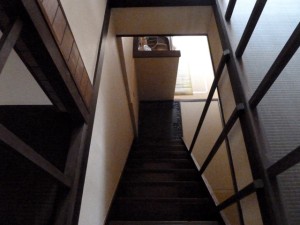 Vielleicht bis auf die steile Treppe, die hinunterführt und unseren steifen Gelenken nach einem Tag langer Stadtwanderungen und nächtlicher harter Unterlagen einiges abverlangt.
Vielleicht bis auf die steile Treppe, die hinunterführt und unseren steifen Gelenken nach einem Tag langer Stadtwanderungen und nächtlicher harter Unterlagen einiges abverlangt.
Die Wände sind dünn und vom kleinen Balkon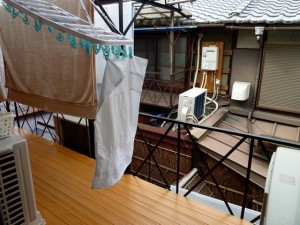 trennt uns nur ein Fliegengitter und ein Bambusrollo.
trennt uns nur ein Fliegengitter und ein Bambusrollo.
Wir schlafen eigentlich gut auf dem ungewohnt harten Untergrund. Aber irgendwann am Morgen, wenn unsere emsigen Mitbewohner schon auf Städtetour sind, ist die Nacht endgültig zu Ende. Denn dann wird geputzt!
Da sitzt er eifrig vor seinem Laptop
und draußen wirbelt und schrubbt es!
 Sechs Zimmer hat es hier, die erwähnten Sanitäranlagen und jeden Morgen eine Grundreinigung, die unserem Frühjahrsputz in nichts nachsteht.
Sechs Zimmer hat es hier, die erwähnten Sanitäranlagen und jeden Morgen eine Grundreinigung, die unserem Frühjahrsputz in nichts nachsteht.
Das Ergebnis kann sich sehen lassen
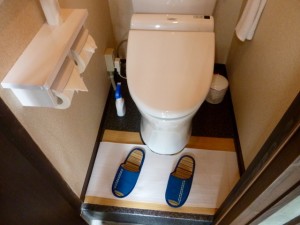
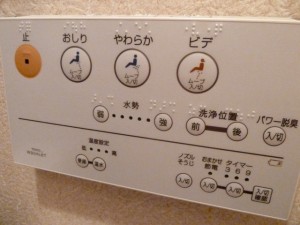

History of the Washlet.
The modern toilet in Japan, in English sometimes called Super Toilet, and commonly known in Japanese as Washlet (ウォシュレット, Washlet?) or as warm-water cleaning toilet seat (温水洗浄便座, onsui senjō benza?) is likely the most advanced type of toilet worldwide, showing a dazzling array of features. The TOTO product Washlet Zoe is listed in the Guinness Book of Records as the world’s most sophisticated toilet with seven functions. However, as the model was introduced in 1997, it is now likely to be inferior to the latest model by Toto Neorest. The idea for the washlet came from abroad, and the first toilet seat with integrated bidet was produced outside of Japan in 1964. The age of the high-tech toilet in Japan started in 1980 with the introduction of the Washlet G Series by TOTO, and since then the product name washlet has been used to refer to all types of Japanese high-tech toilets. As of 2002, almost half of all private homes in Japan have such a toilet, exceeding the number of households with a personal computer.While the toilet looks like a Western-style toilet at first glance, there are a number of additional features, such as blow dryer, seat heating, massage options, water jet adjustments, automatic lid opening, flushing after use, wireless control panels, heating and air conditioning for the room, et cetera, included either as part of the toilet or in the seat. These features can be accessed by a control panel that is either attached to one side of the seat or on a wall nearby, often transmitting the commands wirelessly to the toilet seat.
Yes Janni!
Das ist absolut fabelhaft, was die da an Technik in die Toilette stecken. Ich will schon lange so eine Klobrille!
Das ist einfach klasse, wenn Du das WC betrittst und als erstes fährt vollautomatisch der Klodeckel hoch. Dann ist die Klobrille beheizt und dann erst die „Wasserspiele“ .das macht Spaß 😉
Ich verstehe echt nicht, warum das nicht längst schon auch bei uns seinen Markt gefunden hat.